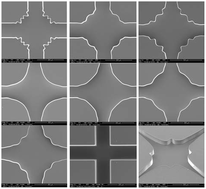Optimized cross-slot microdevices for homogeneous extension†
Abstract
Microfluidic cross-slot devices can generate wide regions of vorticity-free strong extensional flow near the stagnation point, resulting in large extensional deformation and orientation of the microstructure of complex fluids, with possible applications in extensional rheometry and hydrodynamic stretching of single cells or molecules. Standard cross-slot devices, with sharp or rounded corners, generate a flow field with a non-homogeneous extension rate that peaks at the stagnation point, but decays significantly with distance from the stagnation point. To circumvent this limitation, an optimized shape cross-slot extensional rheometer (OSCER) was designed numerically and shown to generate constant extension rate over a wide region of the in- and out-flowing symmetry planes [Haward et al., Phys. Rev. Lett., 2012, 109, 128301]. Since the OSCER device was based on a 2D flow approximation, the practical implementation requires a large aspect ratio, which cannot be reproduced by standard soft-lithography techniques. Here, we propose a set of new designs for optimized cross-slot geometries, considering aspect ratios of order 1 and different lengths of the homogeneous inlet/outlet-flow regions. Micro-particle image velocimetry experiments were carried out in order to validate the flow kinematics, and the velocity profiles were found to be linear along the in- and outflow centrelines in good quantitative agreement with the numerical predictions.


 Please wait while we load your content...
Please wait while we load your content...